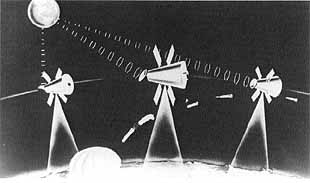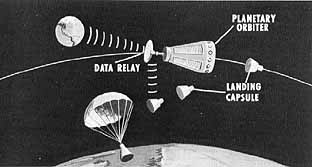-
On Mars:
Exploration of the Red Planet. 1958-1978
-
-
-
- VOYAGER: PERILS OF ADVANCED
PLANNING, 1960-1967
-
-
-
- [83] Voyager was an advanced mission
concept first considered in the spring of 1960 when the NASA staff
was beginning to define its long-range plans for lunar and
planetary missions.1 In their semiannual (l April-30 September 1960)
report to Congress, the agency managers reported that preliminary
mission studies were under way for a second planetary series. The
Voyager orbiters were to be designed to orbit Venus and Mars and
were to be "phased in time and capabilities with the Saturn launch
vehicle.'' Orbits of the planets for long periods would make
possible excellent investigations of their environments, and
landing capsules would he able to provide information on the lower
atmospheres and surfaces. 2 In designing the Voyager spacecraft, NASA engineers
and scientists hoped to use new data gleaned from the Mariner
flights-information that would help them design Voyager's
scientific instruments to answer the proper questions and solve
technological problems posed by Voyager's large size.
-
- Unfortunately, the real world of politics,
with too many projects competing for too few federal dollars, is
seldom as neat as planners hope. For the Voyager proponents, the
real world was an unhappy one. Delays on the Atlas-Centaur launch
vehicle during the early 1960s prompted many changes in the
Mariner project, which in turn delayed the acquisition of
information about the Martian environment essential to the
designers of Voyager. But Kennedy's decision to mount a full-scale
assault on the moon was an even bigger blow for the supporters of
unmanned space exploration. Once the manned Apollo decision had
been made, the Marshall Space Flight Center and its industrial
contractors concentrated on the preparation and production of
Saturns for the lunar missions. Launch vehicles for space science
projects would become available only after the top-priority goal
had been met. From the start, Voyager was by definition a
second-class project. As Congress became restive over the
increased expenditures for Apollo, monies originally marked for
space science and Voyager were reallocated to help pay for the
moon program. Added to this were a costly war in Vietnam and the
domestic troubles of the late 1960s. All post-Apollo missions
proposed by the space agency faced reduced appropriations, which
put....
-
-
-

-
- [whole p84] (One of the first conceptual views of Voyager,
above, was published in the NASA-Industry Plans Conference, July
28-29, 1960. The artist concept below was described by Edgar M.
Cortright during March 1961 NASA hearings before Congress: "This
spacecraft, weighing about 2,400 pounds [1090 kilograms], would be
designed to orbit the target planet and to inject a
several-hundred-pound capsule capable of surviving atmospheric
entry and descent....Thus the orbiting spacecraft would observe
the planet and its atmosphere...., while the landing capsule would
make detailed measurements during descent and on the
groundŠNumerous .... developments are required to accomplish this
difficult but fascinating and distinctly realistic mission, which
may well include among its rewards the discovery of
extraterrestrial life." Senate Committee on Aeronautical and Space
Sciences, NASA Scientific and Technical Programs, hearings, 87th
Cong., 1st sess., 28 Feb., 1 Mar. 1961.)
-

-
-
- [85]....Voyager in deep fiscal trouble by
summer 1967. A request in August from the Manned Spacecraft Center
in Houston for proposals to study manned missions to Mars was the
last bit of bad luck. Congress rebelled and terminated all Voyager
work.
-
- At first glance, it would appear that the
Voyager project of the 1960s, like Mariner B and Mariner 66, was
just another project that never progressed beyond the drafting
table, but it was more than that. Voyager, with thousands of
man-hours of work behind it, performed by dozens of specialists
and costing many millions of dollars, helped to refine art
understanding of the best approaches for a combination
orbiter-lander investigation of Mars. Upon the solid foundations
laid by Voyager personnel, the Viking team that followed them
could construct a successful mission. The story of Voyager's
troubles is essential to an understanding of Viking's
accomplishments.
-
-
-




















